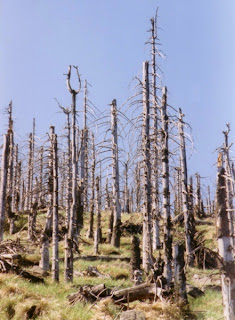There is clear evidence that forests and watercourses are badly affected by the acid rain we produce.
Some species can tolerate acidic waters better than others. However, in an interconnected ecosystem, what impacts some species eventually impacts many more throughout the food chain including non-aquatic species such as birds.
Over one million square kilometeres of Europes forests have
suffered from the effects of acid rain, with conifers suffering most. Sulphur dioxide from the burning of fossil
fuels kills many trees but pollution from traffic also has also has a effect
leaving trees too sick to recover. In
addition to this acid rain washes vital nutrients out of the soil weakening the
trees.
Acid rain also damages forests, especially those at higher elevations. It robs the soil of essential nutrients and releases aluminum in the soil, which makes it hard for trees to take up water. Tree leaves and needles are also harmed by acids. Even slight damage to a mature tree caused by pollution can
be enough to kill it because it reduces the trees frost hardiness and its
resistance to fungi and deadly pests.
Before the introduction of tall smoke stacks and smokeless fuel
in the 1950s only lichens and plants close to industrial areas were affected by
pollution. Now the pollution is less
visible but far more wide reaching.
Acid rain has many ecological effects, but none is greater than its impact on lakes, streams, wetlands and other aquatic environments. Acid rain makes waters acidic and causes them to absorb the aluminum that makes its way from soil into lakes and streams. this combination makes waters toxic to crayfish, clams, fish and other aquatic animals.
Large numbers of fish have died in Norway, Sweden, Scotland, Canada and the eastern USA killed by aluminium released into the water by acid rain. This in turn affects fish eating birds such as the osprey, black or red throated diver, common tern and goosander. It may also delay the recovery of rare animals such as the otter.
Raised aluminium levels brought about by acid rain affect
all the wildlife of an area. Dippers,
together with the insect larvae on which they feed, are now absent from many
streams in mid and north Wales where they once flourished. Aluminium also causes
song-birds like the blue throat, reed bunting and willow warbler to lay eggs
with thin shells, reducing their breeding success year after year. Dead spawn in the surface waters shows that
frogs and toads are dying too.
For related articles click onto:
Caring for the coral reefs
Causes of acid rain
Coral reefs and the greenhouse effect
Conserving fossil fuels
Fossil Fuels
Fossil fuels: Alternative sources of energy
Keystone species
What is acid rain?
What is fracking?
What is global warming?
What is global warming?
What is the greenhouse effect?
What is the difference between neon and fluorescent light?


























